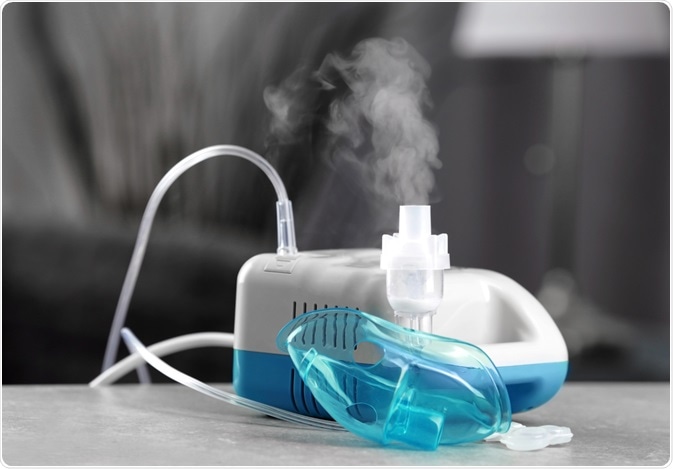There are several ways to deliver medicine to the lungs, such as inhalers. Nebulizers are another type of drug delivery device that turns the medicine into a fine mist that is breathed in. Nebulizers are used to treat a variety of lung conditions, such as wheezing and chest tightness.
 Image Credit: Africa Studio/Shutterstock.com
Image Credit: Africa Studio/Shutterstock.com
Use and applications of nebulizers
Nebulizers can be used to relieve symptoms of various lung conditions by administering both quick-relief medicines and long-term control medicines. Most inhaled medications relieve symptoms such as wheeziness, breathlessness, and tightness in the chest. They can also prevent or slow the accumulation of phlegm and mucus.
Inhalers are a common way of administering drugs, but nebulizers have distinct advantages in several situations. In an emergency situation, such as when breathing becomes difficult and a high dose of medication is needed or when antibiotics are needed against an infection, nebulizers should be used. In these cases, it is done by paramedics or hospital staff.
Nebulizers can also be used in less severe cases at home by individual users. Inhalers are less effective than nebulizers, so nebulizers can be used if the condition it is treating is severe. For example, conditions such as asthma and chronic obstructive pulmonary disease (COPD) can be treated with an inhaler to the same effectiveness. However, conditions such as cystic fibrosis and bronchiectasis can be better treated with nebulizers.
Some other health conditions, such as arthritis, can prevent patients from using inhalers. Furthermore, nebulizers are used for young children and babies. Nebulizers can deliver drugs such as bronchodilators to open the airways, hypertonic saline solutions to loosen up mucus, and antibiotics to treat or prevent infections.
How do nebulizers work?
Nebulizers work by converting a solution into a fine spray, which makes it easier to inhale the drugs. All nebulizers are electric- or battery-powered, unlike handheld inhalers. The fine spray is administered through a mouthpiece or a full facemask, depending on the patient and the requirements. The nebulizer typically has to be used for around 5 to 15 minutes.
There are different types of nebulizers, but most use oxygen, compressed air, or ultrasonic power to convert the liquid drug to a gas form. Ultrasonic nebulizers tend to be more expensive and are typically not used outside of a hospital setting. However, most nebulizers are small and easy to use.
Each time a nebulizer is used, liquid medicine needs to be added to the machine. It is important that for the duration of use, breathing is only done through the mouth. Nose clips are recommended to ensure this. While many can use a simple mouthpiece, fill masks are usually recommended for children.
Nebulizers and COVID-19
COVID-19 is a serious respiratory disease that is currently spreading around the world. As a respiratory disease that can severely affect the lungs, nebulizers have been used in self-medicating and professional settings to manage lung conditions alongside COVID-19. However, there are some concerns about this.
Nebulizers lead to the creation of aerosol particles, which can carry bacteria and viruses deep into the lungs. Transmission of infection by droplet nuclei and aerosols can increase during nebulizer treatment due to the high concentration of aerosols.
Furthermore, there is the possibility that many aerosols are generated that can spread over longer distances than would otherwise naturally occur when they are exhaled from the device. Therefore, while the nebulizer device itself may not spread disease, the effects of droplet formation can lead to transmission of COVID-19 to bystander hosts.
This has caused debate over the use of nebulizers in managing COVID-19. On the one hand, medicine administered this way may be critical in managing the symptoms of COVID-19 and ensuring patients can breathe. On the other hand, the use of nebulizers may contribute to the already widespread infection of the COVID-19 pandemic.
There is also some concern over the immunosuppressive qualities of many inhaled corticosteroids. This could contribute to recommending against the use of nebulizers for patients with COVID-19 or those in proximity to it. However, some other evidence suggests that nebulizers and inhaled corticosteroids can have antiviral properties by blocking viral replication of severe acute respiratory syndrome coronavirus 2 (SARS-CoV-2).
The general advice in many places now is that nebulizer therapy should be reconsidered and only used when absolutely necessary due to the creation of aerosol particles, particularly in places where there are many people around, for example in hotel quarantines. This would entail only using nebulizers when patients have an impending respiratory arrest, patients are uncooperative or unable to use inhalers, or if patients have a history of poor responses to inhalers.
In terms of people with respiratory diseases such as asthma and chronic obstructive pulmonary disease (COPD), they should continue to use prescribed inhaled medications unless advised otherwise by a healthcare professional. They should follow practical advice on how to use these medications during the pandemic.
References
- Ari, A., 2020. Use of aerosolized medications at home for COVID-19. The Lancet Respiratory Medicine.
- Amirav, I. and Newhouse, M., 2020. Transmission of coronavirus by nebulizer: a serious, underappreciated risk. Canadian Medical Association Journal, 192(13), pp. E346-E346.
- British Lung Foundation. 2020. What Is A Nebuliser?. [online] Available at: <https://www.blf.org.uk/support-for-you/nebulisers/what-is-it> [Accessed 29 July 2020].
- Cazzola, M. (2021). Guidance on nebulization during the current COVID-19 pandemic. Respir Med, 176.
- Martin, L., 2020. How To Use A Nebulizer. [online] Medline Plus. Available at: <https://medlineplus.gov/ency/patientinstructions/000006.htm> [Accessed 29 July 2020].
Further Reading